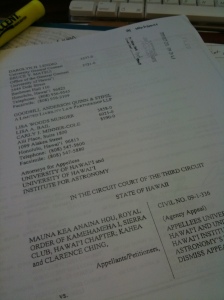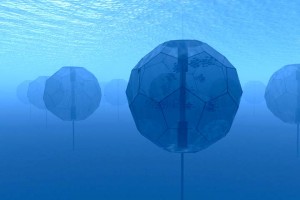Blog
News, updates, finds, stories, and tidbits from staff and community members at KAHEA. Got something to share? Email us at: kahea-alliance@hawaii.rr.com.
Turtle Bay Talkstory II
The Defend Oahu Coalition is looking to you to help keep the country country. A developer is close to receiving the last set of permits necessary to proceed with a massive resort complex on the North Shore. Your participation can help to protect Oahu’s shorelines from construction and the rural character of this community. Take a look at their update below and please try to attend their community meeting tomorrow evening 6:30 pm at Kahuku High School Cafeteria.
TURTLE BAY TALKSTORY II
Tuesday, Dec. 8th at 6:30-9:00
Kahuku High School Cafeteria
From Defend Oahu Coalition:
This is the second in a series of Community Forums regarding the future of Turtle Bay. The City’s Department of Permitting and Planning is reportedly very close to issuing final subdivision permits to the developer at Turtle Bay which will allow him to move ahead with the outdated plan for five additional hotels and one thousand more resort condominiums. The State Supreme Court is set to hear Oral Arguments regarding the Keep the North Shore Country case asking for a Supplemental Environmental Impact Statement.
The existing property is formally changing owners this month, who are reportedly working on a new business model for the resort. This is a crucial time to get updated about the current situation. Efforts aimed at building on plans for preservation as well as sustainable land use enforcement at City and State levels will also be addressed.
Notable speakers invited to attend include: Governor Lingle, Representatives Abercrombie and Hirono, Mayor Hannemann, Turtle Bay Advisory Working Group Chair Bill Paty, Senator Clayton Hee, Councilmember Donovan Dela Cruz and Interim Developer for Kuilima Resort Company Stanford Carr. The moderator for the evening will be Dee Dee Letts, a member of the Ko’olauloa Neighborhood Board and longtime community activist.
Click here to learn more from the DOC.
NEW DUMP OPEN! Loc: 1,000 miles northeast of Hawaii, Pacific Ocean
The Pacific garbage patch is so large it cannot be precisely measured. It is estimated to be twice the size of Texas and one of five in the world. Out of sight, out of mind? I think not. 
Light bulbs, bottle caps, toothbrushes, Popsicle sticks and tiny pieces of plastic, each the size of a grain of rice, inhabit the Pacific garbage patch, an area of widely dispersed trash that doubles in size every decade and is now believed to be roughly twice the size of Texas. But one research organization estimates that the garbage now actually pervades the Pacific, though most of it is caught in what oceanographers call a gyre like this one — an area of heavy currents and slack winds that keep the trash swirling in a giant whirlpool.
PCBs, DDT and other toxic chemicals cannot dissolve in water, but the plastic absorbs them like a sponge. Fish that feed on plankton ingest the tiny plastic particles. Scientists from the Algalita Marine Research Foundation say that fish tissues contain some of the same chemicals as the plastic. The scientists speculate that toxic chemicals are leaching into fish tissue from the plastic they eat.
The researchers say that when a predator — a larger fish or a person — eats the fish that eats the plastic, that predator may be transferring toxins to its own tissues, and in greater concentrations since toxins from multiple food sources can accumulate in the body.
It may be out of sight, but it should be on your mind. After all, the effects could end up in your body.
For the captain’s first mate, Jeffery Ernst, the patch was “just a reminder that there’s nowhere that isn’t affected by humanity.”
To read the rest of the article, click here.
Mauna Kea Case Update: UH files Motion to Dismiss
 On December 9th, the Third Circuit Court will hear oral arguments on the University of Hawaii’s motion to dismiss our case. As reported in the Hawaii Tribune Herald, the University’s argument basically comes down to this quote:
On December 9th, the Third Circuit Court will hear oral arguments on the University of Hawaii’s motion to dismiss our case. As reported in the Hawaii Tribune Herald, the University’s argument basically comes down to this quote:
“In the absence of a contested case hearing, a circuit court is without jurisdiction even to consider the question of whether a contested case hearing was required.”
This motion is the University’s attempt to end this case before both sides have a chance to fully argue the issues for Judge Hara. The issues raised in this case go to the foundation of our collective right to defend our public trust of natural and cultural resources from private exploitation.
The Land Board denied our request for a contested case hearing on the University’s plan to further develop the sacred summit based on the contention that we (Native Hawaiians and the public concerned about protecting the summit) do not have a “property interest” in the mountain. By their logic, without a property interest in the mountain — like a deed — we have no right to challenge the decisions the state makes about the mountain.
We have suffered through many controversial lawsuits under the Lingle Administration. Sadly, this case is no different. The ceded lands case, the Superferry case, the NWHI permit case, and now this new Mauna Kea lawsuit are all examples of the Lingle Administration favoring private exploitation of Hawaii’s resources over the constitutionally protected rights of Native Hawaiians and the public to protect our land. The Administration appears blind to the decades worth of court decisions that have solidified Hawaii’s unique public trust approach to natural and cultural resource protection; seeing only the glint of dollar signs behind every plan to exploit public resources.
This has nothing to do with Hawaii being business-friendly or not and has everything to do with Hawaii being exploited as a testing ground for those seeking to make a buck one way or another: Monsanto, Hawaii Ocean Technology, Inc., TMT Corporation, Superferry, Inc. All of the benefits of these experiments on our land and ocean will be enjoyed by people other than us and all of the risks of these experiments — contamination, damaged land, failed projects — will be suffered by us, those connected to the Hawaiian Islands by more than just paper property interests.
For the generations of kamaaina to come, we cannot allow Hawaii’s unique and effective public trust doctrine to be diluted. That is why we must fight the Land Board’s latest decision about the University’s plan for Mauna Kea. And we could really use your help. Forcing the government to follow its own laws is really expensive. Please consider giving to the Mauna Kea Legal Defense Fund by clicking here or by calling KAHEA at 877-585-2432 (toll-free).
350: the answer to my fears
 From Marti:
From Marti:
Big mahalo to 350.org for organizing the global day of action on October 24, 2009 in support of bringing greenhouse gas emissions down below 350 parts per million. Over 5,200 events were held in more than 180 countries giving rise to the “most widespread day of political action in the planet’s history.” Wow!
We joined in on the demonstrations held in Hawaii and continue to do our part to advocate for 350 in fun and interesting ways (I carved that one myself!). As fun as it was to carve my 350 pumpkin, the gravity of what global warming will do to the Pacific weighed heavy on my soul.
If global temperatures are allowed to rise 2 degrees — which is what world leaders discussed in Barcelona as “tenable” — then that will result in at least a 2-foot rise in sea level. I don’t know about everybody else, but the sudden loss of our coastlines here is anything but tenable. And is nothing but immoral when you’re talking about many inhabited islands throughout the Pacific that are a mere few feet above sea level. Failing to reach the 350 goal in the immediate future means as many as 200,000 people throughout the Pacific will become “climate refugees,” losing their homes, livelihoods, and ways of life to rising sea levels, ocean acidification, and natural disasters, just to name a few of the evils triggered by global warming. Who are you, Mr. World Leader, to decide that is okay? It’s not.
But. If the success of the 350 global day of action demonstrates anything, it is that there is the popular political will around the world necessary to achieve the 350 goal. And, thankfully, now is the time to make this massive global push to end global warming really influence policy decisions.
On an international level, world leaders will be meeting again next month in Copenhagen, Denmark to negotiate an agreement to reduce greenhouse gas emissions.
At the U.S. level, the Obama Administration is expected to release a draft National Ocean Policy by December 9th to address the shocking mismanagement of oceans under U.S. control.
And here in Hawaii, hearings are being held through November by the Greenhouse Gas Emissions Reduction Taskforce on the implementing a fossil fuel fee. Also, the Climate Change Taskforce (of which we are members) will have recommendations for the Legislature to act on when it convenes in January.
Watch for updates on how to participate in all of these decision-making opportunities. Click here to see when and where the Greenhouse Gas Emissions Reduction Taskforce is meeting next.
OOA: The Next Mahele?

Picture of the OOA experiment from HOT, Inc.
From Marti:
The Hawaii Board of Land and Natural Resources just took 250 acres of ocean along the North Kohala coast out of the public trust and gave it all to a private company for experiments in Open Ocean Aquaculture (OOA).
OOA is the practice of raising finfish under controlled conditions, in exposed, high-energy ocean environments. It is distinct from the traditional practice of small scale aquaculture, which raises a limited number of multiple marine species in nearshore fishponds.
On October 23, 2009, the Land Board granted a Conservation District Use Permit (CDUP) to Hawaii Ocean Technology, Inc. so that it can experiment with a new OOA technology. If it works, HOT, Inc. will make millions (maybe even billions). If it doesn’t, HOT, Inc., will walk away and we, the public, will be left with whatever harm their botched experiment causes: impaired water quality, harm to the ocean ecosystem, fish disease, escaped fish, affects of genetically modified material in the ocean, damage from rogue cages…. the list of risks is long.
The loss of public trust ocean resources is a less obvious, but equally long-lasting harm to our oceans.
The CDUP approved last month grants HOT, Inc. an exclusive right to use 250 acres of ocean for their caged fish experiments forever. This means that HOT, Inc. can deny people access to the area, stop them from fishing, harvesting, or boating in the area — kind of like the way “entrepreneurs” came to Hawaii, fenced up open forest land, and “experimented” with raising cows. We all know what *that* experiment did to Hawaii.
Indeed, OOA-proponents seek to “farm the sea as we farm the land, thereby using the vast ocean resource more effectively than is the case presently,” said John Forster in Open Ocean Aquaculture–Moving Forward. It appears he means “effectively” in the “exploit it better and faster” sense of the word.
Is the maze of fences decorated with “no trespassing” signs over every inch of land the future we want for our oceans? That is exactly what we are going to get if this trend is allowed to continue. As outlined in its Ocean Resources Management Plan, the state wants at least 10 OOA ventures in Hawaiian waters. This HOT, Inc. project is the third to come online, and the existing two are already seeking similar privileges to limit public access to the ocean around their cages.
The ocean is a collective resource. A fisherman fishes the sea, but lays no claim to the sea itself or the fish, for that matter. Erecting massive industrial commercial fish farms in the place where fish once swam wild will not save our ocean from the brink of catastrophe. It will push it closer.
We need to stop this mahele of our ocean. Instead, we need to better regulate the commercial (that is exploitive) use of our oceans. We have to enforce the “take what you need and only what you need” mantra of traditional resource management systems that ensured that everyone was fed and the resources endured for generations to come. At same time, we need to better support community-based loko ia, the small-scale nearshore fishponds that not only restore natural ecosystems, but help to provide fish for everyone to eat.
Makahiki Opening Schedule 2009
Help participate in Oahu community efforts to re-establish, perpetuate, and celebrate the opening of Makahiki season and the return of Lono at the following locations. Interested participants please contact event organizers by email if you have any questions concerning protocol, appropriate behavior, attire, and ho’okupu (offerings). Please be mindful and respectful of the traditions of the host community.
KO‘OLAUPOKO DISTRICT – December 4- 6th, 2009
Kualoa (Kualoa Regional Park)
Opening Saturday December 5th
6:30 AM Sunrise procession and ceremony begins
7:30 AM Registration
9:00 AM Päÿani (Makahiki Games)
6:00 PM Dinner and awards (potluck)
Contact : Umi Kai, (ulupono1@gmail.com; 840-5510)
• Families are encouraged to come and camp from Friday until Sunday
• Hawaiian Käne are encouraged to compete in the games (16 yrs and older)
• Interested Hawaiian organizations must email and RSVP in advance
WAI‘ANAE DISTRICT – November 20-21st, 2009
Mäkua (Mäkua Military Reservation)
Friday November 20th Preparation
Saturday Nov. 21st Community Access
9:00 AM Opening Procession and Ceremony
Contact William Aila (ailaw001@hawaii.rr.com; phone 330-0376)
• Mäkua Access is limited
• Interested participants must email and RSVP in advance
• Orientation session required (meetings available every Friday until Makahiki)
More on Turtle Bay EIS: When is old, TOO old?
On Thursday, November 19, 2009 at 11:00 a.m., the Hawaii Supreme Court is scheduled to hear oral arguments in Unite Here! Local 5 v. City and County of Honolulu, the case in which the Intermediate Court of Appeals held that unless the project changes, a supplemental EIS is not required under the Hawaii Environmental Policy Act, Haw. Rev. Stat. ch. 343. The application for writ of certiorari asked the court to review this Question Presented:
Under HRS Chapter 343 an its enabling rules, is a supplemental environmental review required when there are significant changes to a project’s circumstances, such as increased environmental and community impacts, or are supplemental reviews limited solely to changes in project design?
The application for writ of certiorari and opposing and amici briefs in the case thus far are posted here.
The ICA’s opinion is reported at 120 Haw. 457, 209 P.3d 1271 (Haw. Ct. App. 2008), and is posted here. The briefs filed in the ICA are posted here.






